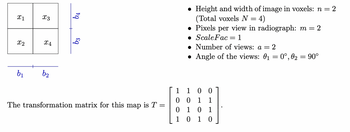
a. Are any nonzero objects invisible to this operator? If so, give an example. We say that an object is nonzero if not all entries are zero. We say that an object is invisible if it produces the zero radiograph.
b. Describe the set of all invisible objects. This could involve an equation that the entries would have to satisfy or a few specific objects that could be used to construct all other such objects.
c. Is it possible for two different objects to produce the same radiograph? If so, give an example.
d. Choose any two objects that produce the same radiograph and subtract them. What is special about the resulting object?
e. Are there radiographs (in the appropriate dimension for the problem) that cannot be produced as the radiograph of any object? If so, give an example.
f. Describe the set of radiographs that can be produced from all possible objects. This may require similar creativity.

Trending nowThis is a popular solution!
Step by stepSolved in 3 steps with 2 images

- question 16arrow_forwardThe domain of discourse for this problem is a group of three people who are working on a project. To make notation easier, the people are numbered 1, 2, 3. The predicate M(x, y) indicates whether x has sent an email to y, so M(2, 3) is read "Person 2 has sent an email to person 3." The table below shows the value of the predicate M(x, y) for each (x, y) pair. The truth value in row r and column y gives the truth value for M(x, y). M | 1 2 | 3 1 TTT 2 TFT 3 TT|F Determine if the quantified statement is true or false. Justify your an- swer. (a) Væ Vy (x # y) → M(x, y)) (b) Væ3y ¬M(x, y) (c) 3r Vy M(x, y)arrow_forwardPlease answer number 18 and 19.arrow_forward
- Question 2. Express each statement in plain English. Then decide if the statement is true or false (including a brief explanation). Both x and y represent real numbers. (1) \xy(x² + y² ≤ 4) (2) \x³y(x² + y² ≤ 4) (3) ³xVy(x² + y² ≤ 4)arrow_forward1.3) Use geometric interpretation to explain whether the following set of equations will have infinitely many solutions, no solution, or a unique solution: f([x;y])=[5;-5] f([x;y])=[0;0] this is all the info I get and I am confused on how to appraoch thisarrow_forward
 Advanced Engineering MathematicsAdvanced MathISBN:9780470458365Author:Erwin KreyszigPublisher:Wiley, John & Sons, Incorporated
Advanced Engineering MathematicsAdvanced MathISBN:9780470458365Author:Erwin KreyszigPublisher:Wiley, John & Sons, Incorporated Numerical Methods for EngineersAdvanced MathISBN:9780073397924Author:Steven C. Chapra Dr., Raymond P. CanalePublisher:McGraw-Hill Education
Numerical Methods for EngineersAdvanced MathISBN:9780073397924Author:Steven C. Chapra Dr., Raymond P. CanalePublisher:McGraw-Hill Education Introductory Mathematics for Engineering Applicat...Advanced MathISBN:9781118141809Author:Nathan KlingbeilPublisher:WILEY
Introductory Mathematics for Engineering Applicat...Advanced MathISBN:9781118141809Author:Nathan KlingbeilPublisher:WILEY Mathematics For Machine TechnologyAdvanced MathISBN:9781337798310Author:Peterson, John.Publisher:Cengage Learning,
Mathematics For Machine TechnologyAdvanced MathISBN:9781337798310Author:Peterson, John.Publisher:Cengage Learning,






